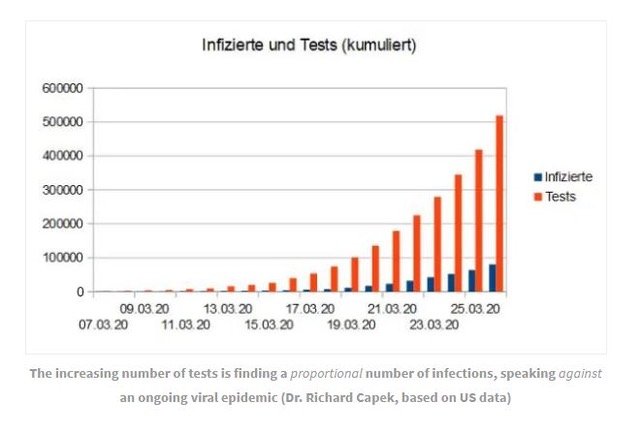This week marks the fifth anniversary of the imposition of lockdown on the British people as a political reaction to the covid ‘pandemic’. At a time when the mainstream media were baying for stronger and longer restrictions,
TCW was almost alone in criticising lockdown and showing that it would have catastrophic results for zero benefit. Will Jones assiduously drew attention to the inconsistencies and recklessness of lockdown policies that became less and less credible the longer they persisted. On Tuesday we republished the first of his articles which appeared just days after the lockdown announcement, on March 25, 2020, and you can read it here. This was his second, on March 29, which we republished yesterday. Today’s article was first published on March 31, 2020.
AS THE number of Covid-19 tests increases worldwide, what are they telling us? Are they, as indicated by mainstream media reporting, showing an epidemic that is spreading exponentially? Or something else? For example, simply revealing through investigation something for which there is no previously data collection to compare it with?
It sounds strange, but a German researcher, Dr Richard Capek, has analysed the tests in the United States and found that although the number of confirmed cases of the virus has been increasing exponentially, that’s because the number of tests has been increasing exponentially. If you look only at the proportion of those tested who test positive, that so far has stayed the same. The latest data from the Robert Koch Institute in Germany agrees with this finding.

What this suggests is that the virus itself may not currently be spreading exponentially if, as a number of virologists have argued, it has been around longer than we have been testing for it.
Dr Capek himself describes this possibility as not so much a viral epidemic but an ‘epidemic of tests’.
A German virology professor, Dr Carsten Scheller from the University of Würzburg, agrees with him, explaining in a podcast that the apparent exponential spread of Covid-19 as presented in the media is more to do with the increasing number of tests than with the spread of the virus itself.
In his view the Wuhan coronavirus is comparable with influenza and so far seems less lethal.
Two Stanford professors of medicine, Dr Eran Bendavid and Dr Jay Bhattacharya, writing in the Wall Street Journal, add their voices to this message, arguing that the lethality of Covid-19 is overestimated by several orders of magnitude and is below that of influenza. The reason for the overestimation, they say, is the greatly underestimated number of people already infected but without symptoms.
But if this is the case, what on earth is going on in Italy and Spain, with hospitals overrun and deaths in the hundreds per day – so many they have now begun registering in Italy’s overall death statistics?
Some have suggested this is not just due to the virus but also to poor air quality, low hospital capacity, a panic-induced collapse of the health system and to the lockdown itself. Dr Gerald Gass, President of the German Hospital Association, has argued that ‘the extreme situation in Italy is mainly due to the very low intensive care capacities‘. Not that this knowledge is any way lessens the health crisis Italy is facing and that we may face.
There are currently many mysteries about the virus and why some countries are affected so much more badly than others, and many theories competing to explain the differences; the hope is to get clues as to how to counter it more effectively.
A key piece of evidence is how widespread the virus really is and how many have already been infected. This is where testing is moving next, with the World Health Organisation urging countries to conduct ‘serosurveys’ that test the blood of a sample of the population to estimate how widely the virus has spread. Such surveys will finally answer the crucial question of how common non-symptomatic infections are and thus give an accurate indication of the true mortality rate of the virus.
Given all this, surely the priority must be to get the world back to work during the epidemic as much as possible, those with symptoms staying at home, and boosting health services so they are better able to cope with the increased demand. It should include restricting travel from heavily infected regions and screening and isolating arrivals (a precaution the UK still has not implemented) but not such costly extreme measures as overriding basic liberties or bringing the economy to a near halt. The terrible risk is that such a ‘cure’ will prove worse than the disease, not least in its impact on physical health, as social distancing hits incomes, and mental health as vulnerable people are isolated and abandoned.
No science is foolproof. Even the lead author of the Imperial College study that spooked the UK government into extreme action has revised down his estimate of deaths from 500,000 to 5,700 (including those who would die this year anyway). Isn’t it time to get things back into proper perspective – not least in dealing with the other deaths and illnesses that beset western societies?











